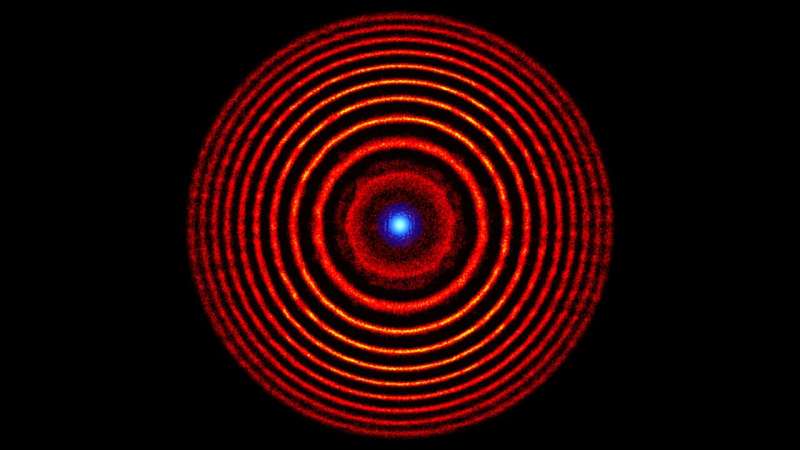An illustration of a holographic plasma lens and the laser focal spot that it creates (blue). Credit: Edwards et al.
Holograms are three-dimensional (3D) images produced by interfering beams of light that reflect physical objects or photographs. In recent years, they were introduced in a variety of settings, for instance to enhance employee training or create more engaging art.
Researchers at Lawrence Livermore National Laboratory, University of California Berkeley, and Princeton University have recently used holography to design a new type of lens made from plasma. This lens, introduced in a paper published in Physical Review Letters, could enable the development of more advanced lasers and optical technologies.
"Our work on plasma lenses came out of a larger effort on plasma optics, where we have been trying to design and build optical components out of plasma rather than more traditional materials, like glass," Matthew Edwards, one of the researchers who carried out the study, told Phys.org. "Plasma is useful as an optical material because it can tolerate far higher light intensity than any solid material, and we can therefore use plasma optics to build compact ultra-high-power lasers. "
The diffractive lenses that Edwards and his colleagues describe in their paper are based on a modified version of plasma volume diffraction grating, a renowned physical tool used to separate colors in incident light. Therefore, when preparing their design, the researchers leveraged knowledge and findings acquired in their previous experiments on gratings.
Essentially, the new holographic plasma lenses use the phase shift occurring when light passes through plasma to create a phase zone plate. This is essentially a type of optic in which the constructive and destructive interference of light produces a high-intensity focal spot after the lens.
"The plasma is created and modified by the interference between a pair of weaker pump lasers," Edwards said. "The advantage of a diffractive lens is that it is resilient to imperfections in plasma density; plasma is difficult to control, so this robustness is important."
The lenses designed by Edwards and his colleagues are based on two collinear pump lasers, with different foci overlapping in a gas jet. As they are made of plasma, they can tolerate very high light intensities, a thousand to a million times higher than those tolerated by glass lenses or lenses based on other non-ionized solid materials.
In their paper, the researchers outline the key design principles of the diffractive plasma lenses. In addition, they present the results of simulations for the two plasma mechanisms underpinning their functioning, namely spatially varying ionization and ponderomotively driven ion-density fluctuations.
Edwards and his colleagues are among the first to design a lens based on experimentally achievable plasma properties. So far, the lens has only been theoretically designed and simulated, but it could soon also be realized experimentally, in laboratory settings.
"The parameters required to experimentally demonstrate the lenses are similar to those that we have achieved with plasma diffraction gratings," Edwards said.
Plasma optics have proved to be highly promising tools, as they are resistant to damage and can be used to manipulate high-intensity light. In the future, the lens created by Edwards and other similar optic components could be used to fabricate highly performing, high-power lasers based on plasma.
"This type of optic potentially enables the creation of lasers with far higher peak powers than what can be built today, opening new regimes of high-intensity physics to exploration," Edwards said. "We are now working on creating a plasma lens in the laboratory, allowing us to experimentally examine the performance and behavior of this type of optic. We are also developing other types of plasma optics, with the goal of creating a comprehensive toolbox of plasma components for manipulating high-power light."
More information: M. R. Edwards et al, Holographic Plasma Lenses, Physical Review Letters (2022). DOI: 10.1103/PhysRevLett.128.065003
Journal information: Physical Review Letters
© 2022 Science X Network























